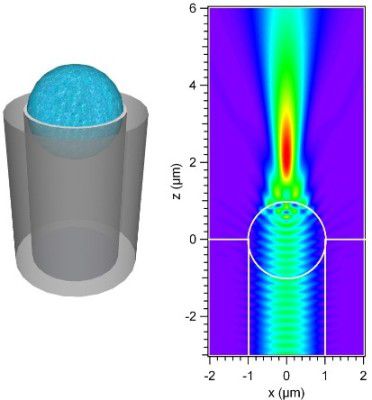recent research work
Latest paper: optical fibers to replace microscopes for single molecule fluorescence detection
Intensity is not enough. Many techniques in optical microscopy take advantage of analysis methods based on single molecule detection events. These measurements provide access to a wide variety of data such as local concentration, structure or mobility of molecules. However, single molecule detection is a challenging task, which requires complex microscope apparatus and is very difficult to take out of the lab.
A mobile endoscope to observe single molecules.
On collaboration with Bordeaux I University (France), my team has recently demonstrated the possibility to detect single fluorescent molecules with an optical fiber. The original system contains a glass microbead at the end of the optical fiber which works as a tiny lens to focus light. The fiber-microbead ensemble is also used to collect the low amount of light emitted by the individual molecules. That way, the bulky microscope is replaced by a remote fiber sensor connected to a miniaturized USB-connected device. This patented technique opens biomedicine and environment monitoring to single molecule analysis.
Reference
H. Aouani, F. Deiss, J. Wenger, P. Ferrand, N. Sojic, H. Rigneault, "Optical-fiber-microsphere for remote fluorescence correlation spectroscopy", Optics Express 17, 18912-18919 (2009)Free download here

Latest paper published : adhesion layer influence in ACS Nano
A nanoscale layer of chromium or titanium is commonly used in plasmonic nanoantennas to firmly adhere a gold film to a glass substrate, yet the influence of this layer on the antenna performance is often ignored. As a result, the need for the use of potentially better materials is not widely recognized.
Using a single nanoaperture milled in a gold film with 120 nm diameter as a nanobench for these investigations, we present the first experimental report of the strong dependence of the plasmonic enhancement of single-molecule fluorescence on the nature of the adhesion layer. By combining fluorescence correlation spectroscopy and fluorescence lifetime measurements, we show that this structure is very sensitive to the properties of the adhesion layer, and we detail the respective contributions of excitation and emission gains to the observed enhanced fluorescence.
Any increase in the absorption losses due to the adhesion layer permittivity or thickness is shown to lower the gains in both excitation and emission, which we relate to a damping of the energy coupling at the nanoaperture.
With this nanobench, we demonstrate the largest enhancement factor reported to date (25×) by using a TiO2 adhesion layer. The experimental data are supported by numerical simulations and argue for a careful consideration of the adhesion layer while designing nanoantennas for high-efficiency single-molecule analysis.
The editorial staff at ACS Nano choose to write a short niews & views on this paper, "Plasmonic Nanoantennas: Tuning in on the Adhesion Layer", see the link here.
Reprints can be ordered via my group's website Mosaic.

Advertisement on blog
Sorry for that inconvenience, and also for not posting during a while. I was quite busy with some kind of scientific Euromillion for young researchers
C'Nano PACA project funded
Porteur : Jérôme Wenger, Institut Fresnel / CNRS UMR6133
Partenaire : Christian Dominici, CP2M / Université Aix-Marseille III
See the link

Fluorescence lifetime measurements with PicoQuant systems
My team is conducting a partnership with PicoQuant GmbH for fluorescence lifetime measurements with time-correlated single photon counting.
As a brief summary, we operate the following PicoQuant devices :
- LDH-P-635 picosecond laser diode working at 636 nm (special spectral selection has been set for free) + Laser diode driver SEPIA-II-SLM828
- Micro Photon Devices MPD-5CTC fast avalanche photodiode, with timing jitter about 50 ps and active area 50 μm
- PicoHarp 300 fast TCSPC module (resolution per channel 4 ps)
Overall, the best temporal resolution of our setup is 120 ps FWHM. We’re pretty pleased with that materials.
Once you get accustomed to TCSPC concepts (which may be a bit tricky at the beginning), the use of PicoQuant systems is very intuitive and efficient.




